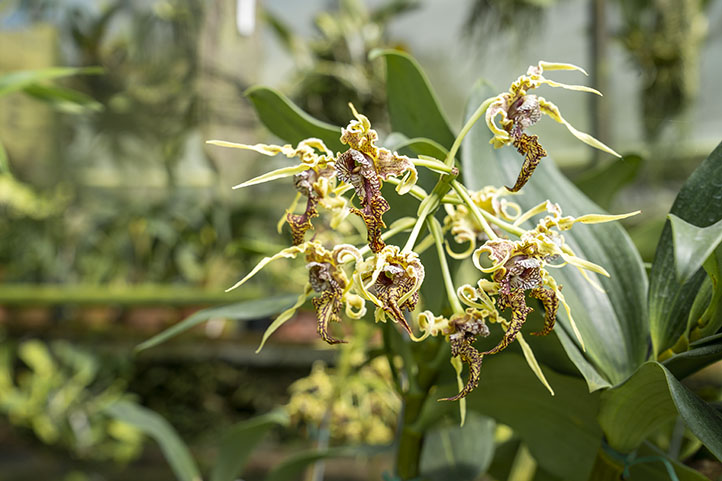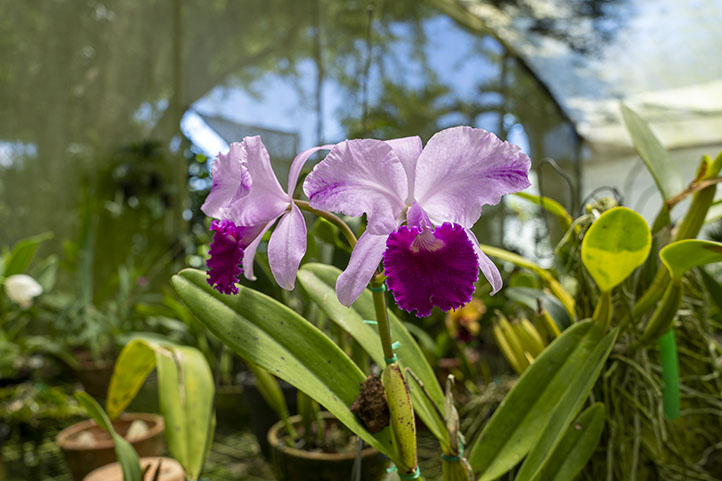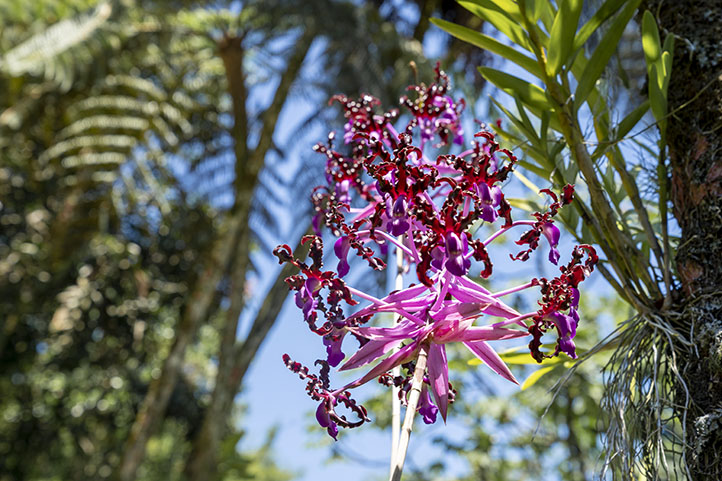Updated on 03/13/2024
Dear reader,
I would also like to recommend our Colombia travel guide, which provides a perfect overview of the tourist attractions in Colombia. Enjoy reading it!
Colombia is a land of incredible biodiversity where world-class research has been carried out to discover its 1400+ species of flowers. New types of orchids are being discovered again and again. This is Colombia, a paradise on earth. Also check out the different languages that are spoken in Colombia.
If you even need more inspiration, check out also are blog with the greatest hotels in Colombia and our city guides.
Content
Why is Colombia famous for its flowers?
Colombia is a privileged area thanks to its geographic location. It is fortunate to be a mega-diverse country and has several tropical features. This fact led, among other things, to Colombia becoming one of the most important flower producers in the world.
It is the country with the greatest diversity of orchids and the second-largest abundance of plants in the world. The Colombian flora has over 1400 endemic species that cannot be found anywhere else in the world. In addition, Colombia has 10% of all plant species that exist worldwide. Among the many surprises that Colombia has to offer the world, the diversity of flora is one of the most outstanding. So when it comes to natural wealth, the answer is always: Colombia! In case you are also considering to travel to Colombia, you definitely should check out our top 99 travel destinations in Colombia.
The Diversity of Climates and Ecosystems of Colombia
Colombia holds a privileged location within the tropics, near the equator, which grants it an average temperature of 24°C (75°F) throughout the year. However, owing to its mountainous terrain formed by the Andes mountain range, Colombia experiences various altitudes that create distinct thermal zones, ranging from warm to glacial. Each thermal zone possesses its own temperature, humidity, precipitation, and sunlight conditions, influencing the type and quantity of flowers that thrive within it.
Furthermore, Colombia boasts two coastlines, one along the Pacific Ocean and the other along the Caribbean Sea, providing access to diverse ocean currents and winds that also impact the climate. For instance, the Pacific coast is wetter and more rainy than the Caribbean coast, fostering the growth of tropical flowers like heliconias. Moreover, Colombia encompasses a wide array of terrestrial and aquatic ecosystems, including jungles, savannas, highland plateaus (“páramos”), deserts, coral reefs, mangroves, and marine prairies, hosting a unique biodiversity on a global scale.
All of these factors contribute to Colombia’s tremendous variety of climates and ecosystems, which is reflected in its flora. According to the Humboldt Institute, Colombia boasts over 51,000 recorded plant species, of which more than 4,000 are endemic (meaning they are found only in Colombia). Among these plants, flowers stand out, particularly orchids, which serve as the national symbol of the country. Colombia houses more than 4,200 orchid species, making it the world’s most diverse country in terms of this type of flower.
Export of Colombian flowers to the world
Colombia is the second most important country when it comes to exporting flowers. We have a very wide and varied range of floral types. The flower sector is therefore of great social importance, as it creates around 1,400 jobs per season, especially for single mothers.
In addition, ecological sustainability programs are used to ensure the continued existence of the species and good treatment of the soil is ensured. 95% of the flowers grown in Colombia are exported, 75% of the production is shipped by air, and 10% goes by sea to countries like Australia, Japan, and the UK. That makes Colombia an export leader.
The exported flowers are grown in the following regions:
- Cundinamarca produces 66% of the carnations, roses, and alstroemeria. This thanks to the conditions of moorland and cold.
- Antioquia produces 32% of its chrysanthemums and hydrangeas thanks to its warm climate.
- Central West (Tolima, Bogota, Boyaca) produces 2% of the roses, sunflowers, and alstroemeria.

Colombian flowers that can be bought in the world
In the high season and for anniversaries, roses are the favorite flowers in over 95 countries to which Colombia exports flowers. On events like Valentine’s Day, foreigners can purchase a variety of the 1,400 species found here. 23% of the exported flowers are roses, 15% carnations, 10% chrysanthemums, 6% alstroemeria, 5% hydrangeas, and 41% are different types of flowers like orchids, sunflowers, lilies, and others. Up to 250,000 tons of flowers are exported on Valentine’s Day alone.
Here are some of the top 95 countries in the world for flowers:
- United States (78%)
- United Kingdom (4%)
- Japan (4%)
- Canada (3%)
- The Netherlands (3%)
- Russia (2%)
The following flowers can be found in these 95 countries:
- Roses: These are the favorite to show love, affection and tenderness.
- Pompons: These mean joy, perfection and eternity.
- Alstroemeria: These represent friendship or eternal commitment. They are very often used at weddings.
- Carnations: their meanings are love and innocence. A perfect gift to start a love affair with.
- Chrysanthemums: These represent abundance and gold.
- Hydrangeas: If you give or receive hydrangeas as a gift, it means that you feel gratitude for this person and that you wish their abundance in life.
- Lilies: Lilies stand for purity, they mean joy and happiness in love.
These are the most famous flowers from Colombia to the world.
Buy or gift a monthly subscription of beautiful floral arrangements at ENJOY FLOWERS for a whole new experience around flowers (only valid in the US).
11 Colombian Flowers You Must See, Buy, and Smell When Visiting Colombia
If you are visiting Colombia, we have some great tips for you. Below is a list of the wonderful flowers of Colombia that you must see or smell. Here are our top 11 most beautiful flowers in Colombia.

Cattleya trianae orchid
Scientific name: Cattleya trianae
Common name: May flower, Colombian orchid
Flowering period: Winter-spring. Their flowers last up to 5 weeks
Origin: Tolima, Huila and Cundinamarca regions
Description of the flower:
It is named in honor of the Colombian doctor and explorer José Jerónimo Triana, who discovered this beautiful species native to the country in 1840. Colombia is known worldwide for having the most beautiful, delicate and exotic orchids.
Its texture and color palette make it an extraordinary flower. It has an epiphytic habit (it grows on trees without feeding on them). Their colors vary between pastel pink, lilac, and yellow in the middle. These different hues in the same flower are what makes it so special and unique. Unfortunately, it is currently threatened with extinction and is one of the most endangered species due to the destruction of its habitat.
Cultural meaning:
This orchid is considered the national symbol of the country as it is a native flower and is commonly known as the “flor de mayo”.
Acacallis cyanea orchid
Scientific name: Aganisia cyanea, Acacallis cyanea
Common name: Acacallis cyanea
Flowering period: It blooms in late winter to summer, mainly in late spring
Origin: Amazon region
Description of the flower:
Acacallis cyanea thrives in forests with high temperatures and very high humidity. Sometimes you can find them on the edge of rivers, part of the plant is covered by the water and only the flowers stick out. This flower can grow up to 25 cm high, its leaves reach up to 20 cm and are light green. Her flowers are a combination of an intense purple mixed with white and a hint of yellow in the middle, which makes them so unique.
Cultural meaning:
In the Amazon, it is considered a sacred flower because it purifies the air, produces oxygen, and increases the humidity in the area. Hence, it is used by the indigenous people to cure diseases, allergies and everything related to the respiratory system.
Heliconia
Scientific name: Heliconia rostrata
Common name: Platanillo
Flowering: After sowing, it takes four months to flower
Origin: Andean region, Santander, Tolima, Risaralda
Description of the flower:
Heliconias are herbaceous, perennial plants, the height of which varies from 90cm to 120cm. They are known abroad as tropical exotics because of their variety of colors, shapes, sizes, and long shelf life. Their colors vary between, red, green, orange and yellow.
Cultural meaning:
This flower is described as the flower of tropical charm and fertility.
Heliconia bird of paradise
Scientific name: Strelitzia reginae
Common name: Bird of Paradise
Flowering period: Spring – summer
Origin: Coastal ecosystems with a warm climate
Description of the flower:
It is a rhizomatous, herbaceous plant from the Heliconia family that was introduced to Colombia in warm climates. This flower is very noticeable because of its bright colors like blue and orange. It is one of the exotic flowers frequently visited by bees, butterflies and hummingbirds. Their size varies between 30 cm and a meter in length.
Cultural meaning:
It is used as an exotic flower for gardens or flower arrangements, and in some regions of the world, it is used as ancient antioxidant medicine.
Colombian rose
Scientific name: Rosa sp
Common name: Rose
Flowering period: Spring – autumn
Origin: Bogota savannah
Description of the flower:
The genus Rosa is formed by a very broad family of flowers and shrubs, which, as a rule, always consists of thorns and Rosaceae. They are known to have a thick and long stem that reaches up to six inches.
Cultural meaning:
The popularity of the rose is so great that it is among the best-selling flowers in the world, it represents a meaning of love and pure feelings, and it is also a symbol of female perseverance. It is used to make flower arrangements, but is also known for its cosmetic properties such as rose water and medicinal uses.
Begonia tuberosa
Scientific name: Begonia x tuberhybrida
Common name: Begonia
Flowering time: Almost all year round
Origin: warm climates such as Cali, Cauca and Antioquia
Description of the flower:
The tuberous begonia is a flower that stands out within the genus of begonias. It is distinguished by the fact that it is exported in flower arrangements because its flowers have a hairy and fleshy surface. They are large and reach about 8 cm. There are different colors of yellow, pink, white and orange. This flower can be grown most of the year, which makes it an export hit because of its ease of cultivation.
Cultural meaning:
According to some legends, begonias are a sign of deep friendship. So whoever gives away begonias swears loyalty to love.
Sugar flower
Scientific name: Begonia semperflorens
Common name: Sugar flower
Flowering time: Almost all year round
Origin: In warm climates, Antioquia, Cali, Armenia
Description of the flower:
This flower is characterized by the fact that it has a round shape and, in most cases, has a gradient between green and red, pink and yellow, white and red. Its flowers appear to be dancing as they are close together and directed upwards. They bloom most of the year and are great for outdoor decoration.
Cultural meaning:
They are beautiful little bushes full of flowers. They are also widely used in outdoor garden decorations and their meaning is innocence.
San Joaquin
Scientific name: Hibiscus rosa-sinensis
Common name: San Joaquín
Flowering period: Between June and August
Origin: Bogotá, Barranquilla, Medellín
Description of the flower:
It is a small shrub, but it can grow to be about 5 meters high, its flowers are large and have about 5 petals. This species has a fantastic variety of colors between pink, red, yellow, orange, white. Although not native to Colombia, it is quite common and consumed in some areas. It is said that its taste is similar to that of spinach.
Cultural meaning:
This flower is widely used in cities for outdoor decoration, gazebo, and city beautification. It has also been used for medical treatments in the past. Nowadays, some people consume these flowers cooked or raw.
Geraniums
Scientific name: Pelargonium spp
Common name: Geraniums
Flowering time: Summer
Origin: Buga and Valle del Cauca
Description of the flower:
Geraniums are very hardy flowers and perfect for outdoor decoration. One of the most representative things about this flower is its sweet, floral aroma and vivid colors that vary between white and purple, red and orange with each bloom. The petals are fleshy and teardrop-shaped and are all of a uniform size that is almost perfect.
Cultural meaning:
Characteristic of the fact that they represent comfort and help overcome any difficulties a person goes through, geraniums are a symbol of resilience.
Carnations
Scientific name: Dianthus caryophyllus
Common name: Carnation, clove pink
Flowering time: Spring
Origin: Bogota savannah
Description of the flower:
Carnations have unique petals because they are puckered and in a spiral shape. They give off a strong and peculiar smell, similar to honey. They display a wide variety of colors, among which pink, red, purple, and white stand out. The flowers are usually one color, but in some seasons these are born with two colors in their petals. Although cloves are not native to Colombia, the country is their largest exporter with more than 4000 hectares of cultivated land.
Cultural meaning:
Carnations are considered to be flirty flowers, full of pure love and innocence, they are very special to show love and commitment.
Tulips
Scientific name: Tulipa
Common name: Tulip
Flowering period: In April and June
Origin: Bogota savannah
Description of the flower:
The tulip is one of the most sought-after flowers among people, which is due to its variety of colors and shapes. Its flowers consist of six petals, in the middle the shape is marked with a beautiful stem with seeds. Its shape is peculiar because it is bell-shaped and closed. Often given as a gift in bouquets, it is also ideal for planting in your own garden.
Cultural meaning:
Tulips are considered the flower of couples and have several meanings depending on their color. For example, in white, they stand for purity and extreme love, whereas when you see yellow tulips, they are associated with joy and friendship.
Colombia Travel Tips
- Colombia Travel Medical Advice & Vaccination Details
- 29 Travel Tips You Need To Know Before Coming To Colombia
- 99 Facts & Information About Colombia You Should Know
- Colombia Weather Guide for Travelers
More Destinations in Colombia
- 99 Must-See Destinations that Will Make You Fall in Love with Colombia
- Colombia’s Top 23 Largest and most Important Cities – Key Data and Insights
- 7 Wonders of Colombia Complete Guide
- Colombia’s Top 117 Museums: A Cultural Traveler’s Comprehensive Journey
- 21 Spectacular Churches in Colombia
- What Are The Best Luxury Destinations In Colombia?
- Sample Luxury Travel Itinerary in Colombia
- Instagram Colombia – The 17 Most Beautiful Places for Photos
Beaches in Colombia
- Colombiafrank’s True Beach Guide – Colombia’s Most Stunning Beaches
- 19 Colombian Paradise Islands You Should Visit Soon
- Rosario Islands & Baru: Don’t Get Scammed and use this Guide
- Cartagena’s Crowded Shores: Unmasking the Reality with Idyllic Alternatives
Bogotá Experiences
- The 9 Most Spectacular Markets In Bogota That You Must Visit
- 15 TOP Must See Attractions in La Candelaria, Bogota Colombia
- Bogota’s 13 Most Beautiful Parks
- Craft Beer Tour in Bogotá – Explore 15 Must-Visit Breweries
Top Activities
- Top 99 Best Activities and Attractions in Bogota
- Top 46 Best Activities and Attractions outside Bogota
- Top 67 Best Activities and Attractions in Medellín
- Top 43 Activities and Attractions outside Medellin
- Top 39 Activities and Attractions in Cartagena
- Top 36 Activities and Attractions outside Cartagena
- Top 23 Activities and Attractions in Santa Marta
- Top 36 Activities and Attractions outside Santa Marta
Other destinations and experiences in Colombia
- 9 Offers for Spiritual Retreats and Yoga in Colombia
- Top 15 Best Romantic Destinations in Colombia for Couples and Honeymoons
- The 11 Best Destinations for Getting Married in Colombia
- The 9 Best and Most Fun Theme Parks in Colombia
- 7 Amazing Tourism Experiences Offered by Former FARC Fighters in Colombia
- Pablo Escobar-related tourism, blessing or curse for Colombia?
- The 9 UNESCO World Heritage Sites in Colombia
- 32 Places to Discover Colombia’s Colonial Architecture
- Wine Tours and Tastings in Colombia – Explore 9 Must-Visit Vineyards
- Colombia’s 22 Most Luxurious Restaurants: Discover Them All
- Where to Find Vegetarian and Vegan Food in Colombia’s Main Cities
- Santuario Las Lajas – The Most Spectacular Basilica in Colombia
- The most important information about Filandia Quindio, Colombia

